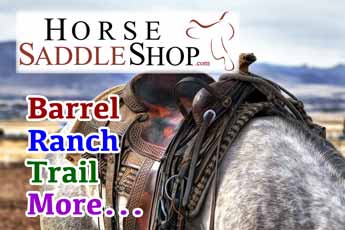What Is The Horse Freeze Branding Process?
Below are photos of horse freeze brands. The photos show freeze brands in various stages, from moments after the horse was branded up to three months later.
Even though some of the information on this page is fairly detailed it is not intended to be a how-to article on freeze branding. It is simply intended to be general information describing items and techniques commonly used in freeze branding, and to show pictures of freeze brands on horses at different stages.
We have a related page with basic information on what freeze branding is and what it's useful for. You can see it here: What Is Freeze Branding?
Below: A freeze brand on the right hip of a horse.

Items Used To Freeze Brand
Below is a list of items used to freeze brand the horses shown in the photos lower on this page:
- Dry ice, about 4.5 pounds.
- Acetone, 1 gallon, to mix with dry ice to form the coolant for the freeze branding iron. Only about two-thirds of the gallon was actually used. (NOTE: 99% alcohol is also commonly used to mix with dry ice to form the coolant, but can sometimes be hard to find. That's why acetone was used instead.)
- Heavy gloves for handling the dry ice, the coolant mixture, and the chilled freeze branding iron.
- Freeze branding iron.
- Electric animal clippers with a #10 blade and a #40 surgical blade.
- Wrist watch with built-in stopwatch, or a stopwatch.
- Styrofoam cooler to transport the dry ice.
- 99% alcohol, 1 quart, for soaking the horses' skin.
- A hammer for pounding the block of dry ice into smaller pieces.
- Safety glasses to wear when pounding on the dry ice and while branding.
- An older, expendable
plastic cooler for holding the dry ice / acetone mixture.
- NOTE: While the plastic cooler shown in the photo below survived just fine, we have heard that a plastic cooler cannot withstand the extreme cold of the coolant mixture and will crack.
- NOTE: While dry ice and 99% alcohol can be used with a Styrofoam cooler, dry ice and acetone cannot; the acetone will dissolve the Styrofoam. See the photo toward the bottom of this page.
Below: A plastic cooler
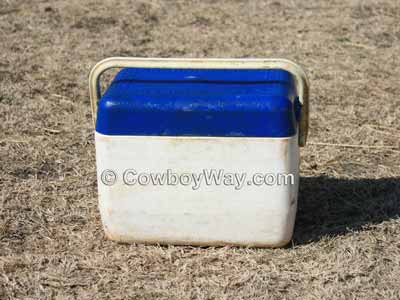
Clipping The Branding Area
Freeze branding requires that all hair be removed from the branding site so that the extreme cold of the freeze branding iron can be applied directly to the skin.
In the photo below you can see the branding site on one of the horses, the right hip, was shaved. The area is a little bigger than the actual brand, and an effort was made to make the bottom edge level to use as a guide when applying the branding iron.
A #10 blade was used first to remove a heavy layer of winter hair, followed by a #40 surgical blade to clip down to the skin.
Below: The shaved freeze branding site on a horse.
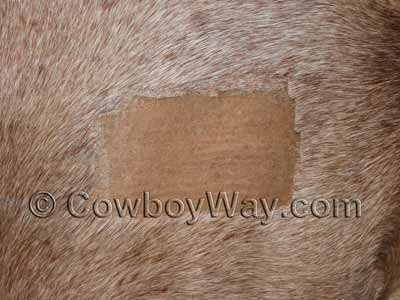
Chilling The Freeze Branding Iron
After the horses were clipped a block of dry ice was broken into golf-ball size pieces with a hammer, then mixed with acetone in a plastic cooler to form the coolant. Note: We strongly recommend wearing goggle or other protective eyewear when breaking up dry ice and/or freeze branding.
Approximately 4.5 pounds of dry ice and 2/3 of a gallon of acetone were used to make the mixture shown below. This was enough dry ice to cover the bottom of the cooler and enough acetone to cover the head of the branding iron by about one inch.
Below: A plastic cooler holding a mixture of dry and acetone, and a freeze branding iron.
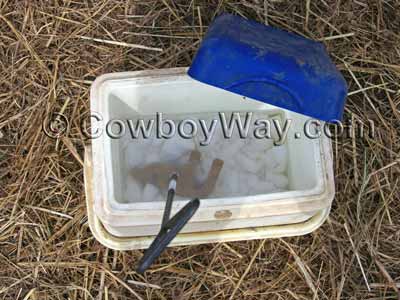
When dry ice and acetone are first combined the mixture will bubble and release a foggy vapor, but will settle down to became still and clear when the mixture has chilled.
When the coolant settles the freeze branding iron can be added.
When the iron is first introduced the coolant will once again bubble and fog. When the bubbling and fogging is finished the iron is chilled and ready to brand. (NOTE: A mixture of dry ice and 99% alcohol - instead of acetone - will stop bubbling but remain somewhat foggy or cloudy when the iron is chilled.)
After each animal is branded the freeze branding iron will need to be put back into the coolant and re-chilled.
Alcohol Soak
After clipping the branding sites and chilling the branding iron, a hole was made in the cap of a quart bottle of 99% alcohol. The first horse to be branded was led into a pipe alleyway and his skin at the branding site was liberally squirted / soaked with the alcohol.
The freeze branding iron was applied IMMEDIATELY after the alcohol soak.
Below: Soaking the branding site with 99% alcohol.
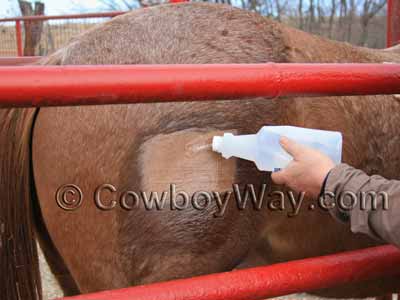
IMMEDIATELY after soaking the freeze branding site with 99% alcohol the freeze branding iron was applied. The iron was applied to the branding site with firm pressure and a gentle rocking motion from side-to-side and top-to-bottom.
The amount of time a horse (or other animal) should be freeze branded will vary according its age, the type of metal the branding iron is made of, the type of coolant being used, and other factors.
Sorry, we don't have a photo of the actual branding. There were just two people present and one was branding while the other one watched the stopwatch.
Seconds After Freeze Branding
When the branding time was up the freeze branding iron was removed from the horse's skin.
Within seconds after freeze branding an indentation of the brand should be easily visible.
The photo below was taken immediately after the freeze branding iron was removed. The indented outline is larger than than the actual size the completed brand will be.
Below: A freeze brand moments after the branding iron was removed.

Minutes After Freeze Branding
Approximately five to ten minutes after branding the indentation that was first visible will begin to disappear and be replaced by a swollen, puffy outline of the brand.
The photo below was taken 40 minutes after the horse was freeze branded and the puffy outline is clearly visible. Like the indented outline in the photo above, the puffy outline is larger than the actual size the completed brand will be.
Below: A 40-minute old freeze brand.

One Day After Freeze Branding
Within two or three days after freeze branding the brand will lose its swollen, puffy appearance.
The photo below was taken 25 hours after the horse was branded and the puffy outline has already diminished greatly.
Below: A 25-hour old freeze brand.

Days / Weeks After Freeze Branding
Several days after freeze branding the brand may be difficult to see, and/or the branded skin may have a flaky or scaly appearance. The brand is likely to go through various stages of flaking or scaling until new hair starts to grow back in, approximately 30 days after branding.
The photo below was taken 15 days after branding.
Below: A 15-day old freeze brand.

Three Months After Freeze Branding
About three months after freeze branding new hair growth should be complete or close to complete.
The photo below was taken three months and six days after the horse was freeze branded. You can see that the hair where the freeze branding iron was applied grew in a nice, bright white.
Below: A three-month old freeze brand.

Freeze Branding Notes
Registering A Brand / Branding Laws
Many states have laws regarding branding livestock and/or other animals. If you
are considering freeze branding, check with your state for any laws that may
apply to branding and/or to registering a brand where you live.
Coolants
The horses in the photos on this page were branded with a coolant mixture of dry
ice and acetone. Other common coolants used for freeze branding are dry ice
and 99% alcohol, and liquid nitrogen.
Styrofoam and Acetone
A Styrofoam cooler has long been a staple in freeze branding for
holding a coolant mixture of dry ice and 99% alcohol.
However, if you are using dry ice and acetone you cannot use Styrofoam since acetone will dissolve it on contact. The photo below shows what happens when even a small amount of acetone comes into contact with Styrofoam.
Below: A Styrofoam cooler that has come into contact with acetone.

99% Alcohol
The alcohol used in freeze branding needs to be 99% alcohol. This
applies to the alcohol used to soak the skin of the animal immediately prior to
branding, and the alcohol used to combine with dry ice to make the coolant for
the branding iron.
Lower percentages of alcohol contain water that can cause a thin layer of ice to form when freeze branding, decreasing the penetration of cold into the skin.
While 99% alcohol was readily available in years past it can now sometimes be difficult to find, especially in larger quantities such as gallons. This is why acetone is often used instead of 99% alcohol to mix with dry ice to make the coolant.
However, 99% alcohol is still needed to put on the skin of the horse (or other animal) immediately before applying the freeze branding iron. 99% alcohol can often be found through a local veterinarian or pharmacy, but it might not be in stock and may need to be ordered. It can also often be found for sale on various websites.
Clothing and Safety Glasses
If you are freeze branding, heavy gloves, a shirt with long sleeves, and long
pants (as opposed to shorts) should be worn when handling dry ice and/or any coolant.
It's also a good idea to wear safety glasses when breaking up the
dry ice and when branding.
Branding Times
The amount of time a freeze branding iron should be applied to a horse (or other
animal) varies according to the type of animal, its age, the type of coolant
used, the type of metal the branding iron is made of, and other factors.
If you are considering freeze branding and need suggested branding times, consult with someone experienced with freeze branding and/or the manufacturer of the branding iron you will be using.
If you're curious, for the finished freeze brand shown above the horse was a three-year old red roan gelding, the coolant used was dry ice and acetone, the freeze branding iron was made by L & H, and the freeze branding iron was applied for 24 seconds.
Sedation
It is not uncommon to sedate a horse during the freeze branding
procedure. Sedation helps to insure the horse holds very still while the
freeze branding iron is applied, which greatly helps the brander to apply
the firm, consistent pressure that results in a clear brand. Sedating a
horse also helps to minimize concerns some horse owners feel about their
horse experiencing pain while being freeze branded.
However, sedation always carries a few risks. If you are considering sedating a horse for freeze branding, consult a veterinarian experienced both with horses and freeze branding for their opinion.
Freeze Branding Dogs
Here is an interesting article about freeze branding dogs:
http://www.coondawgs.com/freezebrand.html
(<<<this link will open in a new window).
More Information On Dry Ice
For more information on dry ice you can see:
http://www.dryiceinfo.com
(<<<this link will open in a new window)..
Brand Design Tips
When designing your brand, try to keep any letters and symbols you are using as
open as possible.
For example, the letters "H" and "L" are far more open than letters like "B" and "R" with their small, enclosed areas. The more open a symbol or letter is the more likely it is the brand will show up clearly and be easily readable.
Avoiding small, enclosed areas with a freeze brand design is not as important as when designing a hot brand, however, as freeze brands are more tolerant of small areas.
When designing your freeze brand become a keen observer of other people's freeze brands to see what did and did not turn out clearly, and ask for advice from people experienced with applying freeze brands.
For text and photos on what freeze branding is and what it's useful for, please see this page: What is Freeze Branding?
What Is / Are...
… What Are 5 Of The Biggest Wild West Robberies?
… What Are 5 Reasons Horse Trailer Lighting Matters?
… What Are 8 Dumb Things To Say To A Horse Lover?
… What Are 9 Proven Ways To Keep Flies Off Horses?
… What Are Chestnuts and Ergots?
… What Are The Parts Of A Western Saddle?
… What Are Saddle Rigging Positions?
… What Are Some Fencing Options?
… What Are Some Foods Both Horses And Dogs Can Eat?
… What Are Some Horse Fencing Basics?
… What Are Some Interesting Horse Facts?
… What Are Some Interesting Charts and Graphs With Horse Information?
… What Are Some Options For Temporary Horse Fencing?
… What Are Synthetic Saddles Made Of?
… What Are The Rodeo Catch Pens?
… What Are The 10 Best 3-Horse Trailers With Living Quarters In The USA And Canada?
… What Are The X's In A Cowboy Hat?
… What Are The Three Legal Head Catches?
… What Is The Angle System For Branding?
… What Is The Barrel Racing Pattern?
… What Is A Bull Riding Vest Made Of?
… What Is Deworming Your Horse?
… What Is A Domain Name?
Why would I need one for my farm or ranch even if I don't have or
want a website?
… What Is A Fifth Wheel Trailer Hitch?
… What Is Flag and National Anthem Etiquette At A Rodeo?
… What Is A Slant Load Horse Trailer?
… What Is Floating A Horse's Teeth?
… What Do Horse Freeze Brands Look Like?
… What Is A Galvayne's Groove?
… What Is A Gooseneck Trailer Hitch?
… What Is Some History About The First National Finals Rodeo?
… What Is The History Of The Modern, Hornless, Bronc Riding Saddle?
… What Is The History Of The Modern Rodeo Bucking Chute?
… What Is The History Of The One-Hand Bareback Rigging?
… What Is The Nasolacrimal Duct In Horses?
… What Is A Pony Express Mochila?
… What Is Hermann Oak Leather?
… What Is Larvicidal De-Worming?
… What Is The Flehmen Response?
… What Is The Rodeo Return Gate?
… What Is A Safety Tip For Posting The Colors?
… What Is A Slick Fork Saddle?
… What Is A Swell Fork Saddle?
You Might Also Like
